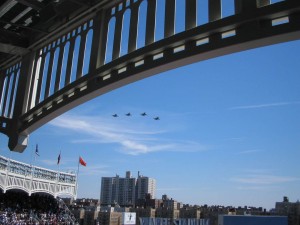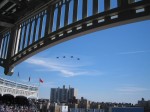 Bronx, N.Y., April 16, 2009 — I learned a painful lesson about being exact with my language watching the Yankees battle the Indians in the opener of the new Yankee Stadium Thursday afternoon. As has been covered everywhere, the new “Palace” is beautiful, if expensive, and it is assumed that Yankee fans both experienced and new, old and young, will adapt to it, as long as much of the magic that permeated the Baseball Cathedral across 161st Street makes it across to the new digs. In good times and in bad, the day of the Home Opener was certainly a magical day over there, particularly since it was modified and reopened in 1976. In the 33 years of home openers in that Stadium, the record was a lofty 26-8 (which adds up to 34 because they dropped a double header opener following a six-day-delaying blizzard in 1982). That magic, it appears, will be delayed making it to the other side of Babe Ruth Plaza.
Bronx, N.Y., April 16, 2009 — I learned a painful lesson about being exact with my language watching the Yankees battle the Indians in the opener of the new Yankee Stadium Thursday afternoon. As has been covered everywhere, the new “Palace” is beautiful, if expensive, and it is assumed that Yankee fans both experienced and new, old and young, will adapt to it, as long as much of the magic that permeated the Baseball Cathedral across 161st Street makes it across to the new digs. In good times and in bad, the day of the Home Opener was certainly a magical day over there, particularly since it was modified and reopened in 1976. In the 33 years of home openers in that Stadium, the record was a lofty 26-8 (which adds up to 34 because they dropped a double header opener following a six-day-delaying blizzard in 1982). That magic, it appears, will be delayed making it to the other side of Babe Ruth Plaza.
Newly signed free agent ace C.C. Sabathia took the mound in this game, coming off a bad start and then a very good one, both on the longest season-opening road trip the Yanks have ever had. It became clear pretty soon that we would be seeing some of both performances this time. When Sabathia gave up the ball two outs into the top of the sixth, he had allowed just five hits and one run, but it took him 122 pitches and five walks on nine three-ball counts to get there. C.C. had a great 95-mph heater, an unhittable change about 10 mph slower, and a mid-seventies killer curve, but he had command of none of them.
Watching him survive back-to-back, one-out walks in the third and almost make it through a challenging fourth inning unscathed with some help on a great diving, catch-and-throw play by third baseman Cody Ransom, the word that popped into my head for his outing was “ugly.” Wrong. Unfortunately, two members of the Yankee pen would be around three frames later to show me what that word actually entailed. Sabathia’s pitching could rightly be called “labored” perhaps, but in retrospect the word “heroic” fits too, because he was subduing the Cleveland offense despite having little control over where his pitches were going. After surrendering his lone tally on a Kelly Shoppach fourth-inning double, he got through a 30-pitch fifth when Jorge Posada nailed Grady Sizemore stealing after a one-out walk, just before back-to-back singles. C.C.’s one-out walk in the sixth could have become the lead run once a Ransom error and an infield single off reliever Edwar Ramirez filled the bases, but young southpaw Phil Coke redeemed himself from some recent struggles by retiring Sizemore to close the frame.
The seventh came, and I got my language lesson. Righty Jose Veras had contributed a game-changing walk to a late K.C. rally in a loss last week, and he and lefty Damaso Marte brought a very different mood to the festivities in a killer inning this time. There was no more agony over a walk or a soft single to someone after two great pitches had them down 0-2. No good pitches were wasted as the pair of relief assassins did their work in assembly-line fashion. Four-pitch leadoff walk, first-pitch double, and full-count double and Veras was gone after 12 pitches and two runs. Marte relieved and in a span of four tosses hit a batter, failed to nab a baserunner at third on a sac bunt attempt, and allowed a one-base hit. With the Yanks now down 4-1 with the sacks filled, ten more throws produced the first out, an rbi walk, and a grand slam home run that the crowd was sure was the piece de resistance. But no, four pitches later first baseman Victor Martinez capped the nine-run onslaught with a monster bomb to left.
The Yankees replied with their second tally on a leadoff walk to Melky Cabrera, pinch-hitting for a slightly banged-up Mark Teixeira, and an rbi by Robbie Cano on one of his three singles. But that was it, and the hometeam fell 10-2. You could call the Yankee offense “labored” this day as well, but not heroic. They had Indians lefty Cliff Lee in trouble every inning, recording hits/left-on-base numbers in the first five innings of 1/2, 1/1, 2/2, 1/3, and 2/2. Jorge Posada suppled the offense with a home run to dead center at the foot of the retired numbers in the fifth, but unfortunately, as usual it preceded the followup walk and single, rather than cashing them in. The Yanks went 1-for-11 (plus two walks and a hit by pitch) with men in scoring position.
This day dawned with just a smattering of clouds remaining from the last storm front, and a horde of Yankee fans anxious to finally see baseball that mattered played in the new place were greeted by bright sunny skies with a cool breeze. The Yankees had announced that the festivities in the gleaning Stadium would be starting shortly after noon, and at 12:12, we heard the words, “Good afternoon, Ladies and Gentlemen, and welcome to Yankee Stadium” piped in in Bob Sheppard’s voice. It was a recorded message, but we hold out hope for a future ballpark appearance. John Sterling followed that with a tribute to George Steinbrenner, who was shown acknowledging the crowd’s applause from his box as Sterling dubbed him, “The Greatest Owner in Baseball…” Looking around at the new Palace, with the heroes honored in Monument Park and the 26 Championships, six under Steinbrenner’s ownership, it was impossible to disagree. Michael Kay introduced the U.S. Army West Point Band performing marching and military music (e.g., “The Washington Post March,” “Anchors Aweigh”), just as John Philip Souza and a host of others had performed when the original Stadium was opened in 1923.
Sterling then introduced recording star John Fogarty, who made as if he was playing a guitar made out of a bat as he sang “Centerfield” while Earle Combs, Joe DiMaggio, Mickey Mantle, Bobby Murcer, Mickey Rivers, and Bernie Williams were featured in highlights on the big video screen. Then Bernie Williams took his place in center and played a fine acoustic version of “Take Me Out to the Ballgame” to tumultuous cheers, and what I like to call the “double-44 moment” arrived. Reading alphabetically, Sterling and Kay introduced 44 Yankee stars from the years the team played across the street, starting with Luis Arroyo through Dave Winfield. Each strode out from the third base side, proceeding in an arc toward first, as they ringed the infield grass. The pitching rubber and home plate from the last game last year, we learned, would be used in this contest, and then they would be enshrined in the Yankee Museum, one of the many reminders the new place holds of what came before. Then the players from the Indians were introduced, most mildly cheered or booed, with the exception of number 44, Carl Pavano, who received as lusty a boo as one would expect off his nonperformance in New York for four years.
The Yankee staff and players were announced next, ending with Manager Joe Girardi and the starters. Seventy-five West Point cadets unfurled a huge American flag in center field while Kelly Clarkson sang our National Anthem, punctuated at the end by a flyover of four F-16’s. No one in the park was surprised when Yogi Berra followed by tossing the ceremonial first pitch. We are lucky to have so many great ex-players around to attend these parties, and Yogi (and Whitey Ford — who looked great, by the way) most of all. The final chapter of the Opening Ceremonies would take place 20 minutes later after Sabathia had retired the visitors in order in the top of the first. The bat that Babe Ruth used to hit Yankee Stadium’s first home run 86 years ago was laid across the plate before Derek Jeter led off the bottom of the first.
Then the Yankees played a game in which their offense threatened repeatedly, but failed to score for the most part. There’s just one way you win that kind of game: with a “heroic” pitching effort. Perhaps tomorrow. Same time, same place.
YANKEE BASEBALL!!!
